The Amish are known for a few things: their no-tech lifestyle, sustainability, and their amazing recipes. The Amish simplistic lifestyle is combined with their need to be more self-sufficient. This is due to their belief in God.
The Amish are a religious community who look towards a bishop as to what rules they follow. Unlike their counterparts, Mennonites, Amish are typically unable to use electricity, cars, and most other conveniences that we are accustomed to in the modern era.
By using canning techniques, they are best able to store their food long-term, which is really important when you do not have a fridge to turn to! Amish communities live off the land. Because they have a lot of kids, preserving food is a must to ensure that everyone eats as well.
⇒ Learn How To Get 295 Pounds Of Extra Food For Just $5 A Week
Their lifestyle can show us ‘English’ that it is truly possible to live a life without modern conveniences and to use everything that is available.
Watermelon rind pickles are just that. These sweet and salty pickles make a fantastic addition to salads, and sandwiches, or even eaten as a refreshing snack.
Now, let’s get to the recipe.
Here’s What You Need:
- 1 medium-sized ripe watermelon rind with the green peel taken off
- 1 cup salt
- 6 cups sugar
- 4 cups vinegar (I used white, but apple cider vinegar would be great too)
- 3 tablespoon pickling spices or spices of your choice
- pint canning jars
- canning pot
- quart sauce pot
- mixing bowl
Directions
Step 1: Slice your watermelon into 1 inch cubes. Leave some of the red flesh on these. Cut off the green shell and place your rinds into a mixing bowl.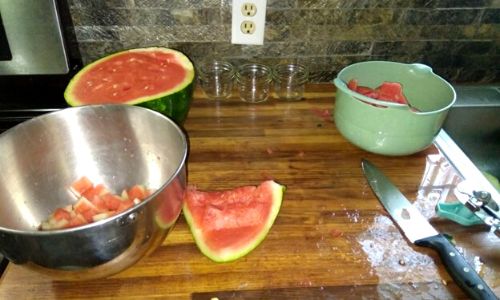
Add in your salt and cover until the top of the watermelon rind is covered with water. Let soak for at least 30 minutes and up to overnight.
Step 2: While your rind is soaking inside the salt brine, it is time to make a sweet brine. Mix your sugar, spices, and vinegar into your quart saucepan. Bring this to a boil.
If you do not want whole spices inside your pickle brine, strain these out.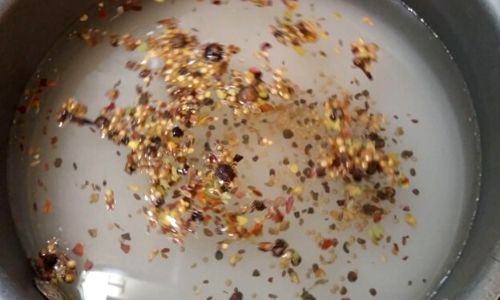
Step 3: Take your canning jars and lids and disinfect them by putting them into your canning pot and boiling them. This is very important to help prevent botulism.
⇒ 5 Ingenious Ways To Refrigerate Your Food Without Electricity
Step 4: Drain your watermelon rinds and put them to the side. If you soaked the rinds overnight, rinse with cold water.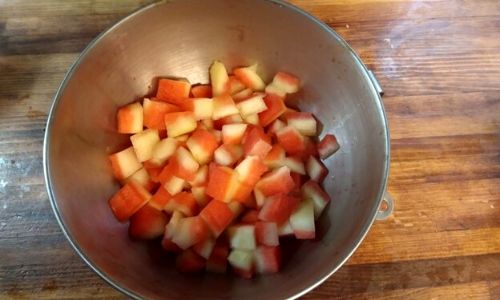
Step 5: Take these jars out of the water after being boiled for 10 minutes. This allows the proper time to have any bacteria killed. Pack these jars with your watermelon rinds and then add your brine in.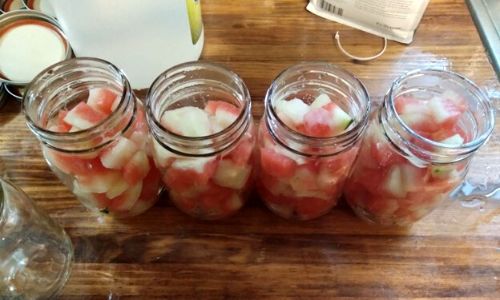
You should allow your canning jar to have appropriate headspace. For watermelon pickles, a ½ inch headspace is the proper space.
Related: My Grandma’s Method of Canning Eggplant
Wipe around the rim to make sure that your jars will seal properly, which is essential to shelf life! Place lids onto your filled canning jars and then twist your ring on.
Step 6: Place your filled cans inside your waterbath; the water should cover the tops of the jars. Process these at a simmer for 10 minutes. It is important to not let the jars touch during this process or they will not seal properly.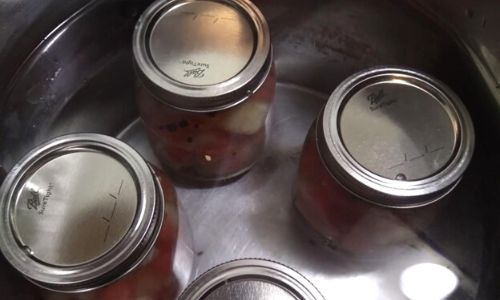
Once finished pull your finished jars out of your pot. Do not move them too much during the first 24 hours to allow for your jars to seal properly.
Step 7: Allow to cool overnight. Within 24 hours, your jars should be sealed. These pickles are shelf stable for at least a year. The longer your pickles sit in the brine, the better they will taste.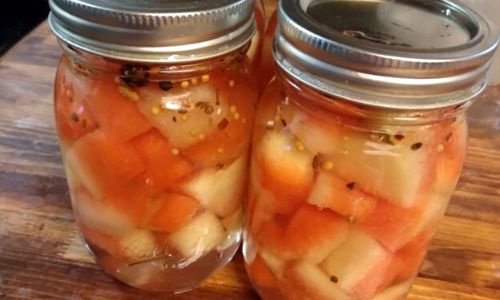
Some of the spices you can use are endless. I used a basic premade pickling spice blend; however, you could use any of the following: ginger, peppercorn, cinnamon, bay leaves. mustard seed, fennel, coriander.
There are many others as well. But considering that this is a sweet pickle recipe, I tend to lean more towards the warmer flavors like ginger.
I ended up having extra brine, which I took and made pickled onions. The brine turned out to be a sweet and flavorful brine. I used the onions on chicken tacos and the watermelon rind in a nice chicken salad. The mixture of sweet and spice was a wonderful addition.
The Importance Of Food Canning
Canning safely is important. Knowing how to have safe food is what the Amish do best. When the S.H.T.F, they will not need help from others to sustain themselves, so as preppers, we should look towards them to ensure that we are ready for not if but when something happens.
Another benefit of having a nice variety of foods inside your stockpile is being able to make far more recipes than a select few.
There are many ways of ensuring that your shelf life lasts far longer. Make sure you remove the ring from your jar when storing it. While it may seem counterproductive, removing the ring is essential to ensuring that your jar seal is not false.
Another important consideration is that your jars should be stored in a cool dry place. Rotate your stock pile often to preserve freshness as well.
The number one way to make sure you have the best storage for canning is to make sure you can your food correctly. Improperly canned foods will degrade in nutrients faster and even go rancid.
By having a stockpile, you are creating for sustainability for yourself and your family! Using things like watermelon rinds is a way to use food that would otherwise be wasted. I even took the skins from the rinds and fed them to our chickens, making this recipe waste free.

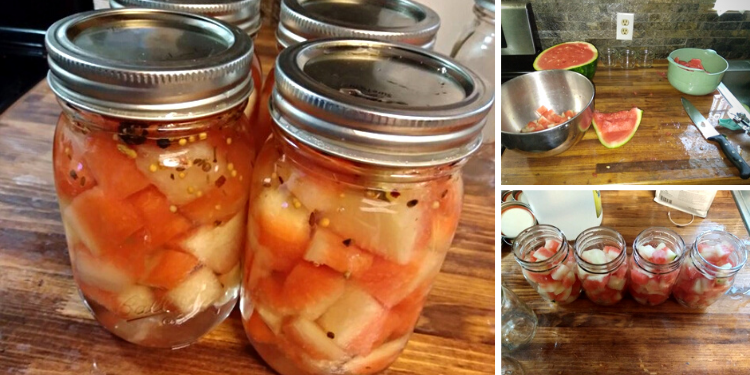













Good well written article. Sadly that sounds grooss
It is very good glad to say , this was our Christmas candy when I was a child growing up , both my Mother and Grandmother made Brooks Christmas Candy .still to this day I make it ,plus watermelon jelly and watermelon butter
Watermelon butter? Please tell me more?
I love watermelon pickles and use a similar recipe.
just wanted to say thank you for writing these articles. Got one for how to convince the grown kids you live with, to permit you to grow things as well as get a couple of chickens for eggs????? We live in the out skirt of town so we can, from what I’m told, can have at least 6 hens but no roosters. While the thought was to raise an empty double spaced dog house for shade and to roost, my kids don’t want to have birds or goats or sheep or pigs or even a garden since the ones I tried before were pitifully low producing to feed a family of 8. But I guess all the stuff you plant in one 8 by 4 raised bed could be a bit crowded when that is all the space your allowed to have. I had hoped to have it go vertical but she doesn’t want that either. Oh well,
Angela I can’t bend down like I use to so I have made myself raised beds for my veggies, then like tomato’s I put a plant in each flower boot , this year I’m raising potatoes in a old rusted metal wagon , they are doing great can hardly wait to see my yield, plant garden in cord board boxes , that works great , then at end of season put it all into compost pile boxes rots and great soil inhibitor . Gl and God Bless
Try container gardening. You can grow a surprising amount in a growing tower or similar arrangement, while using very little space AND remaining portable. How can anyone object if you grow veggies and herbs in the same space a house plant would take? Plus, fresh herbs are pleasant smelling and really punch up a dish, especially if it’s a processed, factory produced dish like many settle for. Woo them with fresh herbs and they might start seeing the value in using space for gardening other edibles! Container gardening can also be easier on the back and joints than crouching down even for a raised bed garden.
I haven’t tried this yet but definitely want to and since the rind is similar to the flesh of a cucumber I think it should take on the taste of the pickling brine and taste very similar to a bread and butter pickle. Especially if you added thinly sliced onions to the mixture.
Going to have to get me a watermelon and try this can’t wait.
You are so right I can every year DONT freeze much at all due to if they take the electric I’ve lost all that food , I keep my skill of collecting herbs from the wild , my next task is to make Queen Ann Lace Jelly , I already have my corncob jelly and syrup done for the year .
Folks you really need to learn how to live off the land and start canning all that you can get . That time of famine is nearer than you think , burning the factories, buying all the farm land, cost of living , wake up people only you can save your self and your family . For the government isn’t going to all they know how to do it take take take . Don’t store all your goods in one spot either be prepared for them . God bless you all .
Wishing you would give us the recipe for Queen Anne’s Lace jelly!
There are quite a few QAL jelly recipes around. I’ve used this one successfully.
Queen Anne’s Lace Jelly
Makes Approximately 2 Pints
18 fresh, large Queen Anne’s Lace flower heads*
4 cups boiling water
1/4 cup lemon juice
4 cups sugar
2 packages powdered pectin
3 drops natural red food coloring, if desired
1. Fill the sink or a large bowl with cold water. Submerge flower heads in the water and slosh around to remove any insects. Drain flowers.
2. Place the flowers in a large pot** and cover with boiling water. Cover and let sit for several hours or overnight. Essentially, you are making a very strong, stinky Queen Anne’s Lace tea.
3. Strain the cooled “tea” through a sieve lined with cheesecloth. Save the tea, discard the flowers.
4. Rinse your pot and add the tea back in. Heat over a medium-high flame. Add the lemon juice, sugar and pectin. Stir to dissolve and bring to a boil. Boil for one minute, then reduce heat to medium. Stir frequently and be sure to scrape the bottom of the pan to prevent burning. Cook for 8-10 minutes until thickened (a good “set” test is to place a plate in the freezer for 15 minutes. Drop a small spoonful of the jelly onto the cold plate. After 30 seconds, the jelly should form a soft set and not run).
5. If you wish, add food coloring to the jelly to give it a peachy-pink color. Otherwise, the jelly with be a very light chartreuse color.
6. Pour jelly into sterilized mason jars or other storage container. Keep in the refrigerator or process in a hot water bath for five minutes. Enjoy!
I recently made four pints of watermelon rind pickles from my first homegrown watermelon. They are refrigerater bread & butter pickles. I didn’t waterbath can them because I used a stevia eurithrital blend for the sugar to make these low carb and because I’m allergic to cane sugar. If anyone knows if it would be safe to waterbath can with these ingredients please send me some feedback. I have 8 more melons almost ripe and I would love to put up a bunch more but there will be no room in my fridge!! Thank you in advance ?
JM,
Contact your Coumty Extension office. Those folks are a font of knowledge.
If your Stevia mix isn’t able to be WB canned, ask them whT would be a sugar alternative.
I have heard , NO verification, that Monk Fruit sweeteners can be used. Again, I have NOT verified this yet. Do your own home work, but that is where I am going to ask.
Hope this helps.
Peace
MadFab
I have heard of this years ago and will give it a try. Sounds great.
By any chance can you use other melon rinds?
Other melons don’t grow as thick a find but last year I pickled the watermelon flesh as well as separate jars of rind so I would imagine you could pickle other melons if you cut them into chunks that included the flesh as well as the rind. Might be worth an experiment.
I used a recipe that called for boiling the rinds in the brine until transparent it came out great. I used cinnamon sticks, whole allspice, cloves and cardamom as well as some mustard seed.. Very yummy!. Boil the spices in the pot of rind and add a cinnamon stick to each jar while filling them. Try various combinations of the spices for separate batches to see which you prefer.
*Rind, not Find.
Recipe? Please!
We save watermelon rinds and use them in all pickle recipes. They freeze well, too, where cucumbers don’t. niio
Good day to you. I am unable to purchase Your books as the there is sadly no option to purchase from South Africa
I have never tried watermelon rind pickles. While a lot of people like sweet pickles I do not. I am thinking of trying this with a more traditional type of pickling brine. A more savory recipe. Or maybe I will make both recipes and see which one the family likes best. Thanks for the great information and recipe!
Stay safe and God Bless…
I have always had pickled watermelon rinds with cinnamon
My grandma didn’t make these pickles, but she made a watermelon marmalade that was awesome! She peeled the tough green rind off, and there was only a hint of the pink inner part, it was mostly just the white part – she shredded or grated it, and just cooked it down with sugar like any old fashioned fruit jam.
I experimented and pretty much reproduced it many years ago, I think I shredded a little Orange or Lemon rind into it, but I don’t have a recipe. I have watermelons again this year – may have to make a few jars. We LOVED it on ice cream when we went to her house.
This article brings back memories. Can I use iodized salt or non iodize salt.?
You can use iodized salt for pickling, however, non-iodized salt is preferred. Iodized salt has additives that can make the brine look cloudy.
Is there any reason why the green part of the rind is removed prior to pickling? It is my understanding that there are a lot of excellent nutrients in watermelon rind, such as: Vitamin A, Vitamin C, potassium, Vitamin B6 and zinc. It is loaded with citrulline, chlorophyll, amino acids, lycopene, phenolic compounds and flavonoids.
Everything in moderation, of course!
Recipe plz